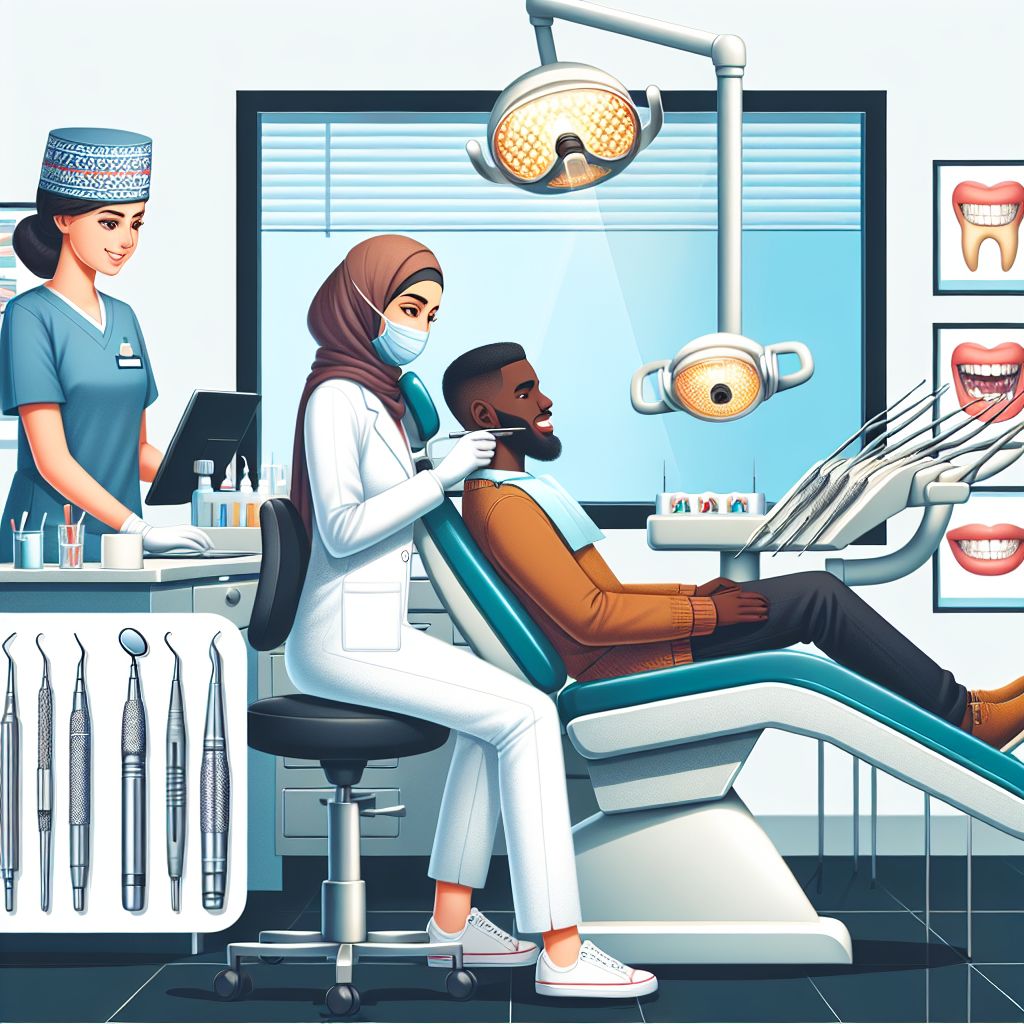Key Takeaways
- Brush your teeth twice a day with a fluoride toothpaste to protect gum health.
- Floss daily to remove plaque from places your toothbrush can’t reach.
- Eat a balanced diet and quit smoking to boost your overall gum health.
- Schedule regular dental check-ups and cleanings for professional care.
- Be aware of the signs of gum disease, such as bleeding or swollen gums, and seek prompt treatment.
When it comes to the health of your gums, there’s a lot more at stake than just your teeth. Your gums are the foundation of your smile and the guardians of your teeth’s well-being. So, let’s dive into the world of gum health and arm you with tips and techniques to prevent gum disease. Because, after all, a healthy smile is a beautiful smile.
Start With a Winning Smile: Why Gum Health Matters
Gum health might not be the first thing you think about when considering your overall health, but it should be. Healthy gums are critical for maintaining strong teeth and a vibrant smile. Moreover, they play a significant role in your overall well-being. Gum disease, if left unchecked, can lead to tooth loss and has been linked to more serious conditions like heart disease and diabetes.
The Consequences of Ignoring Gum Health
Ignoring your gums can lead to gingivitis, an inflammation of the gums, which can progress to periodontitis, a more serious infection that can damage the soft tissue and bone supporting your teeth. The most alarming part? You might not even know you have it until it’s too late. That’s why taking proactive steps to prevent gum disease is crucial.

Understanding the Link Between Gum Disease and Overall Health
- Gum disease can increase the risk of heart disease and stroke.
- Pregnant women with gum disease may face higher risks of preterm birth and low birth weight babies.
- Diabetes and gum disease have a two-way relationship; each can potentially exacerbate the other.
It’s clear that the health of your gums is more than just about your mouth. Infections in the gums can enter the bloodstream, potentially affecting other areas of the body. Therefore, maintaining healthy gums is not just about preserving your smile—it’s about protecting your health from head to toe.
Brushing Up on Basics: Daily Oral Hygiene
The cornerstone of preventing gum disease lies in the daily rituals you perform at your bathroom sink. It’s about consistency and technique, ensuring that every nook and cranny in your mouth is free from plaque—the main culprit behind gum disease.
Picking the Right Toothbrush
The toothbrush is your primary weapon against plaque. But not all toothbrushes are created equal. Choose a soft-bristled brush that fits comfortably in your mouth and reaches all areas easily. Electric toothbrushes can be more effective in reducing plaque and gingivitis, so they’re worth considering, especially if you have trouble with manual brushing.
The Truth About Toothpaste: Does Fluoride Matter?
When it comes to toothpaste, fluoride is your friend. Fluoride strengthens tooth enamel and helps prevent decay. It’s essential for fighting the bacteria that can lead to gum disease. So, yes, using fluoride toothpaste is a simple yet powerful step in your gum disease prevention routine.
The Art of Brushing: Technique for Healthier Gums
Brushing your teeth is about more than just scrubbing away food particles. It’s a skill that, when done correctly, can significantly impact your gum health. Here’s how to do it right:
- Place your toothbrush at a 45-degree angle to your gums.
- Use gentle, circular motions to clean the teeth and gums.
- Don’t forget the back teeth, and brush your tongue to remove bacteria.
- Brush for two minutes, twice a day, for the best results.
Remember, brushing too hard can damage your gums, so keep it gentle. And while we’re on the subject of brushing, let’s not forget about flossing.
Why Flossing Shouldn’t Be an Afterthought
Flossing is not just a suggestion; it’s a necessity for disrupting the colonies of bacteria that settle between your teeth where your brush can’t reach. Flossing once a day is crucial for removing the plaque and food particles that lead to gum disease. If you’re not a fan of traditional floss, there are alternatives like water flossers or interdental brushes that can do the job just as well.
Mouthwash Use: Helpful or Just Freshening?
While mouthwash should not replace brushing and flossing, it’s a helpful adjunct. Therapeutic mouthwashes can reduce plaque, prevent or reduce gingivitis, reduce the speed that tartar develops, or a combination of these benefits. Plus, the act of rinsing is another opportunity to dislodge food particles and bacteria. Just look for a mouthwash with the ADA Seal of Acceptance to ensure it’s effective.
Check-Ups and Cleanings: Your Dental Safety Net
Even with impeccable oral hygiene at home, professional cleanings are non-negotiable. Dentists and hygienists can catch and address issues long before you might notice anything’s amiss. They’re your safety net, ensuring that any gum disease is caught early and treated effectively.
How Often Should You Visit the Dentist?
Most people should see the dentist for a check-up and cleaning twice a year. However, if you have a history of gum disease or other oral health issues, your dentist might recommend more frequent visits. These appointments are essential for preventing gum disease and catching it in the early stages when it’s most treatable.
The Plaque and Tartar Take-down: Understanding Professional Cleanings
During a professional cleaning, the dental hygienist will remove plaque and tartar (hardened plaque) that brushing and flossing can’t tackle. This process, known as scaling, is crucial because tartar provides the perfect breeding ground for bacteria that cause gum disease. They’ll also polish your teeth, making it more difficult for plaque to stick to them in the future.
Lifestyle Adjustments: Beyond the Bathroom Sink
Your daily habits play a significant role in the health of your gums. It’s not just about what happens in the bathroom; it’s about the choices you make throughout your day that can either support or undermine your gum health.
- Eat a balanced diet rich in vitamins and minerals to support gum health.
- Stay hydrated to promote saliva production, which naturally cleanses the mouth.
- Quit smoking, as it’s one of the most significant risk factors for gum disease.
These lifestyle choices can have a profound impact on the health of your gums and your overall well-being.
The Diet-Gum Health Connection: Foods to Eat and Avoid
What you eat matters for your gums. Foods rich in vitamin C and calcium can bolster gum health, while sticky, sugary foods can contribute to plaque build-up. So, load up on fresh fruits and vegetables, dairy products, and lean proteins, and limit your intake of sugary snacks and drinks.
Smoking Cessation: A Breath of Fresh Air for Your Gums
Smoking is a major enemy of gum health. It impairs blood flow to the gums, which can affect the healing process and increase the risk of gum disease. Kicking the habit is one of the best things you can do for your gums and your overall health. If you need help quitting, talk to your doctor about cessation programs and aids.
Stress and Gums: The Unseen Link
Stress can also impact your gum health by weakening your immune system, making it harder for your body to fight off infections like gum disease. Managing stress through activities like exercise, meditation, or talking to a therapist can help protect your gums and your overall health.
Advanced Care Options: When Prevention Isn’t Enough
Sometimes, despite our best efforts, gum disease can take hold. When that happens, it’s essential to know that there are advanced care options available to help restore your gum health.
Scaling and Root Planing – An Essential Fight Against Gum Disease
If gum disease progresses, a procedure called scaling and root planing may be necessary. This deep-cleaning process goes beneath the gum line to remove tartar and bacteria from the tooth roots. It’s a crucial step in managing gum disease and preventing further damage to your gums and teeth.
Gum surgery is often the next step when deep cleaning isn’t enough to halt the progression of periodontitis. Procedures like flap surgery, which involves lifting the gums to remove tartar, and bone and tissue grafts, which aim to regenerate any bone or gum tissue lost to periodontitis, can be necessary to maintain oral health.
Gum Surgery: Types and What to Expect
When gum disease reaches a stage where it cannot be treated with non-surgical methods, your dentist might recommend surgical interventions. Common types of gum surgery include flap surgery to clean the roots of teeth and reduce the gap between the gum and tooth, and grafts to replace lost bone or gum tissue. Your dentist will discuss the best option for your specific situation.
Option A.
How Can I Tell If My Gums Are Healthy?
Healthy gums are firm, pink, and do not bleed during brushing or flossing. They fit snugly around the teeth without any swelling or redness. If you notice any changes in the appearance or sensation in your gums, it’s a good idea to consult your dentist.
Is It Normal for My Gums to Bleed When I Brush?
No, bleeding gums are not normal and often indicate gingivitis, the early stage of gum disease. Improving your brushing and flossing routine can often resolve this issue, but if bleeding persists, it’s important to visit your dentist.
Example: Sarah noticed her gums bleeding when she brushed her teeth. Concerned, she improved her oral hygiene and scheduled a visit with her dentist. After a professional cleaning and adopting a more thorough brushing and flossing routine, her gums stopped bleeding and returned to a healthy state.
What Are the First Signs of Gum Disease?
The first signs of gum disease include red, swollen gums that bleed easily, bad breath, and a bad taste in your mouth. If you notice any of these symptoms, it’s important to take action immediately to prevent further progression.
Can Children Get Gum Disease?
Yes, children can develop gum disease. While it’s less common than in adults, poor oral hygiene, a diet high in sugar, and genetic predisposition can increase a child’s risk. Teaching children good dental habits early is key to preventing gum disease.
By following these tips and techniques, you can take control of your gum health and prevent gum disease. Remember, a beautiful smile starts with healthy gums, so give them the care they deserve. Regular check-ups, proper oral hygiene, and a healthy lifestyle are the best ways to ensure that your gums stay healthy, paving the way for a lifetime of beautiful smiles.

2 thoughts on “Preventing Gum Disease: Tips and Techniques”